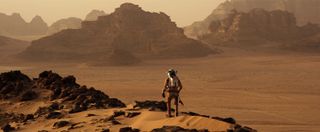Does 'The Martian' Movie Do the Book Justice? Yes. Yes, It Does

Movies adapted from successful books don't always capture the magic of the original text — and the calculation- and science-heavy story of "The Martian" seems a particularly tough customer — but the upcoming film does a surprisingly good job conjuring the book's spirit. The new movie, opening Friday, trades some of the book's nonstop danger for glorious Martian vistas and more NASA at work, and I'm not complaining.
As a quick note, this article doesn't spoil major plot points but does discuss the major themes of the book and movie.
The movie "The Martian," is based on Andy Weir's book of the same name, and tells the story of an astronaut who is accidentally left behind on Mars and must struggle to survive. When watching "The Martian," all I could think was that the movie version of protagonist Mark Watney had it easy. Sure, almost everything he does goes sideways and presents a new challenge for him to ponder, calculate and build his way out of. But there are a lot of major problems presented in the book that movie-Watney doesn't encounter while stranded on Mars, and several complicated, clever solutions he never has to devise. [Watch: How to Kill (or Save) a Martian – Author Andy Weir Knows!]

Then again, having it easier than book-Watney leaves plenty of room for death-defying exploits, and "The Martian" movie still manages to capture the feel of the book, while making the characters within NASA more vivid and focusing even more on what makes space travel compelling.
Weir's novel about an astronaut's fight to stay alive alone on Mars started as a series of chapters posted one by one on his website before he self-published the whole sequence in 2011. In 2014, Crown Publishing released a physical book, and just a year later, 20th Century Fox is releasing a movie. (In fact, the two deals were struck within a week of each other.)
The heart of the novel, and of the new movie, is Watney's log entries, in which he describes the projects he undertakes and conveys his thoughts as he endures his time on the Red Planet. In the movie, the logs become video recordings, but they keep the same tone as the written logs in the book, full of humor and quips despite the dire circumstances. (Some of the book's best lines made their way into the movie, and even into the trailers, which I considered a good sign.) Those logs, which are essentially a dialogue with the audience, go a long way toward keeping the tight focus on one isolated man interesting in both book and film.

But in the movie, Watney shares the screen with another, inescapable character: the Red Planet itself. In the book, Mars reaches out and periodically makes itself known — producing the particular conditions that challenge Watney during his journey — but Mars' constant, giant emptiness; fierce weather; and looming landscapes are much more present in the visual medium. Where in the book Watney fills up the audience's view, because readers are only seeing his words, in the movie Watney is almost always shown at his proper scale in comparison to the vast, isolated planet.
Get the Space.com Newsletter
Breaking space news, the latest updates on rocket launches, skywatching events and more!
Other elements that benefit from the movie treatment are the machinations, collaboration and debate by people within NASA. Although those aspects are included in the book, they don't shine quite as much as Watney's narration. Seeing the personalities on screen, explaining a seemingly impossible spaceship maneuver or digging up old technology to try to rig a solution to a communications problem, makes those scenes much more of a treat.
Basically, this movie makes space travel look awesome. It makes it look challenging and dangerous and fallible. And it conveys, perhaps better than the book does, a gut feeling of why space travel is worth doing — and that it's filled with smart people improvising doing their best with the situation they're in. [Read chapter one of "The Martian"]
Those smart solutions are by necessity less detailed in the movie than in the book. Though they seem to be consistent in both the book and the movie, Watney's thought processes (and NASA's) are explained meticulously in the novel, but they are only hinted at on-screen. It's a difficult screenwriting challenge to capture the exhilarating moment of solving a problem without the full explanation of how that solution works. Nonetheless, the moments the film does choose to explain more carefully succeed in conveying that feeling.
In an essay by Weir included at the end of the Crown edition of "The Martian," entitled "How Science Made Me a Writer," Weir discusses the way the actual conditions on Mars, and the fundamental problems they would cause, acted as a base for his storytelling and dictated the course of the story.
"Science creates plot!" Weir wrote. "No need for meteor strikes — the surprises, catastrophes, and narrow escapes were coming fast and furious on their own."
That drive is carried over into the movie, and so in a basic sense, even if it doesn't match the book challenge for challenge, the movie succeeds at capturing what makes the book so riveting.
Email Sarah Lewin at slewin@space.com or follow her @SarahExplains. Follow us @Spacedotcom, Facebook and Google+. Original article on Space.com.
Join our Space Forums to keep talking space on the latest missions, night sky and more! And if you have a news tip, correction or comment, let us know at: community@space.com.

Sarah Lewin started writing for Space.com in June of 2015 as a Staff Writer and became Associate Editor in 2019 . Her work has been featured by Scientific American, IEEE Spectrum, Quanta Magazine, Wired, The Scientist, Science Friday and WGBH's Inside NOVA. Sarah has an MA from NYU's Science, Health and Environmental Reporting Program and an AB in mathematics from Brown University. When not writing, reading or thinking about space, Sarah enjoys musical theatre and mathematical papercraft. She is currently Assistant News Editor at Scientific American. You can follow her on Twitter @SarahExplains.
